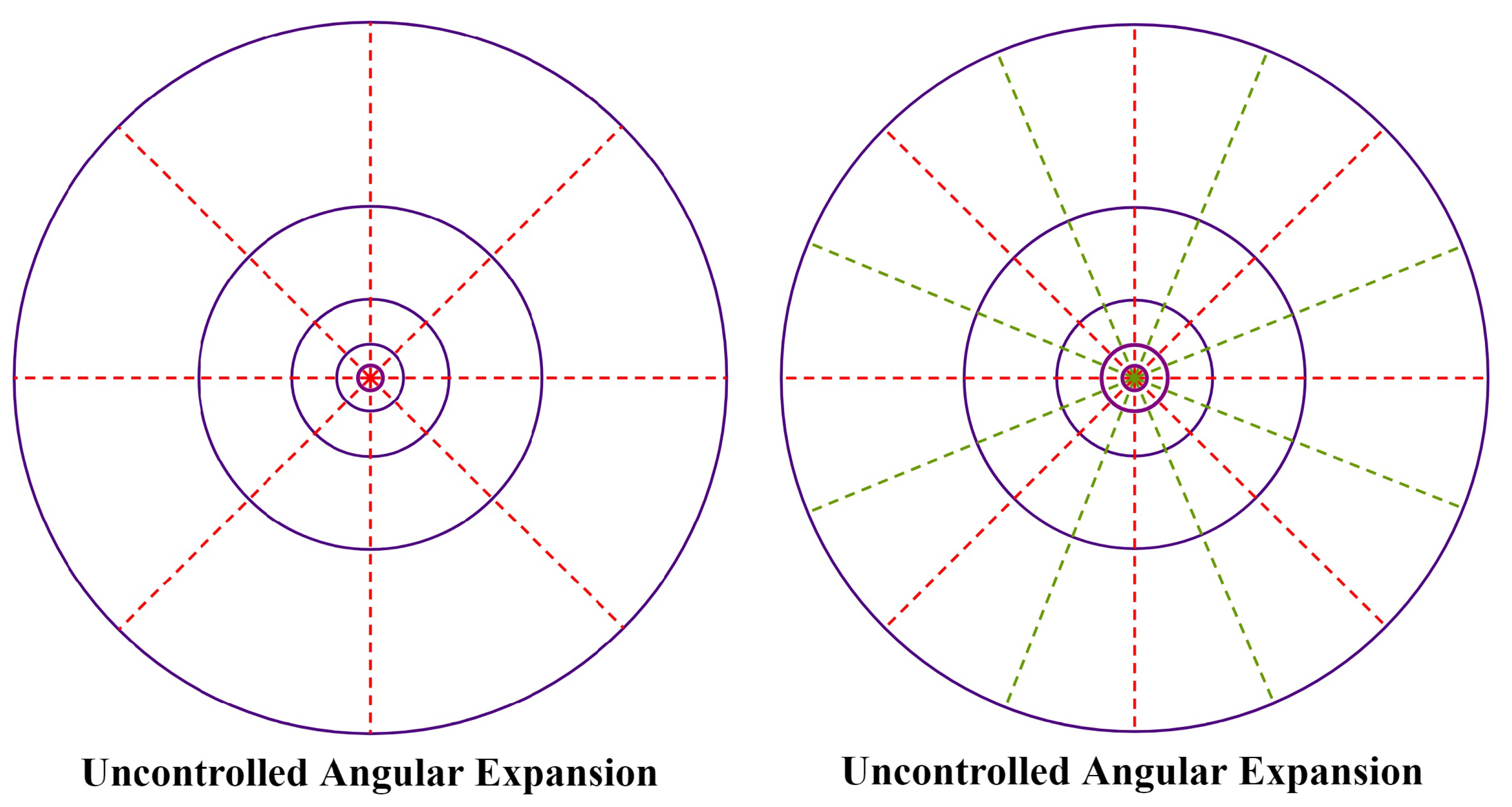A New Discretization Scheme for the Non-Isotropic Stockwell Transform
Abstract
1. Introduction
- (i).
- The frequency variable is discretized by choosing , where and . Consequently, the matrix given by (3) takes the form:
- (ii).
- The angular parameter is discretized by sub-dividing the interval into -equally spaced angles by taking , where and .
- (iii).
- For and , the translation parameter is discretized by taking into consideration both of the preceding discretizations of and and choosing .
2. Discourse on the New Discretization Scheme
- (i).
- The discretization of the frequency variable is achieved via the parabolic scaling law by choosing , where is a fixed integer and determines the level of resolution. Consequently, the anisotropy matrix is given byand the discretized frequency variable can be expressed via the matrix as
- (ii)
- For fixed , the rotation parameter is sampled into equi-spaced pieces asTo prevent the expansion of the angular region at higher values of , it is desirable to make the spacing between the consecutive angles scale-dependent. As such, we choose , where denotes the integral part of . Consequently, the scale-dependent angular discretization is given below:
- (iii)
- The discretization of the spatial variable is carried out by taking into consideration both the previous discretizations of frequency and angular variables. For and , the spatial variable is sampled as


3. The Non-Isotropic Stockwell Frames
4. Conclusions and Future Work
Author Contributions
Funding
Data Availability Statement
Conflicts of Interest
References
- Stockwell, R.G.; Mansinha, L.; Lowe, R.P. Localization of the complex spectrum: The S-transform. IEEE Trans. Signal. Process. 1996, 44, 998–1001. [Google Scholar] [CrossRef]
- Gabor, D. Theory of communications. J. Inst. Electr. Eng. 1946, 93, 429–457. [Google Scholar] [CrossRef]
- Debnath, L.; Shah, F.A. Wavelet Transforms and Their Applications; Birkhäuser: New York, NY, USA, 2015. [Google Scholar]
- Debnath, L.; Shah, F.A. Lecture Notes on Wavelet Transforms; Birkhäuser: Boston, MA, USA, 2017. [Google Scholar]
- Shah, F.A.; Tantary, A.Y. Wavelet Transforms: Kith and Kin; Chapman and Hall/CRC: Boca Raton, FL, USA, 2022. [Google Scholar]
- Stockwell, R.G. A basis for efficient representation of the S-transform. Digit. Signal Process. 2007, 17, 371–393. [Google Scholar] [CrossRef]
- Du, J.; Wong, M.W.; Zhu, H. Continuous and discrete inversion formulas for the Stockwell transform. Integral Transform. Spec. Funct. 2007, 50, 537–543. [Google Scholar] [CrossRef]
- Drabycz, S.; Stockwell, R.G.; Mitchell, J.R. Image texture characterization using the discrete orthonormal S-transform. J. Digit. Imaging 2009, 22, 696–708. [Google Scholar] [CrossRef] [PubMed]
- Moukadem, A.; Bouguila, Z.; Abdeslam, D.O.; Dieterlen, A. A new optimized Stockwell transform applied on synthetic and real non-stationary signals. Digit. Signal Process. 2015, 46, 226–238. [Google Scholar] [CrossRef]
- Shah, F.A.; Tantary, A.Y. Linear canonical Stockwell transform. J. Math. Anal. Appl. 2020, 484, 123673. [Google Scholar] [CrossRef]
- Shah, F.A.; Tantary, A.Y. Non-isotropic angular Stockwell transform and the associated uncertainty principles. Appl. Anal. 2021, 100, 835–859. [Google Scholar] [CrossRef]
- Soleimani, M.; Vahidi, A.; Vaseghi, B. Two-dimensional Stockwell transform and deep convolutional neural network for multi-class diagnosis of pathological brain. IEEE Tran. Neural Sys. Rehab. Engn. 2021, 29, 163–172. [Google Scholar] [CrossRef] [PubMed]
Disclaimer/Publisher’s Note: The statements, opinions and data contained in all publications are solely those of the individual author(s) and contributor(s) and not of MDPI and/or the editor(s). MDPI and/or the editor(s) disclaim responsibility for any injury to people or property resulting from any ideas, methods, instructions or products referred to in the content. |
© 2023 by the authors. Licensee MDPI, Basel, Switzerland. This article is an open access article distributed under the terms and conditions of the Creative Commons Attribution (CC BY) license (https://creativecommons.org/licenses/by/4.0/).
Share and Cite
Srivastava, H.M.; Tantary, A.Y.; Shah, F.A. A New Discretization Scheme for the Non-Isotropic Stockwell Transform. Mathematics 2023, 11, 1839. https://doi.org/10.3390/math11081839
Srivastava HM, Tantary AY, Shah FA. A New Discretization Scheme for the Non-Isotropic Stockwell Transform. Mathematics. 2023; 11(8):1839. https://doi.org/10.3390/math11081839
Chicago/Turabian StyleSrivastava, Hari M., Azhar Y. Tantary, and Firdous A. Shah. 2023. "A New Discretization Scheme for the Non-Isotropic Stockwell Transform" Mathematics 11, no. 8: 1839. https://doi.org/10.3390/math11081839
APA StyleSrivastava, H. M., Tantary, A. Y., & Shah, F. A. (2023). A New Discretization Scheme for the Non-Isotropic Stockwell Transform. Mathematics, 11(8), 1839. https://doi.org/10.3390/math11081839





